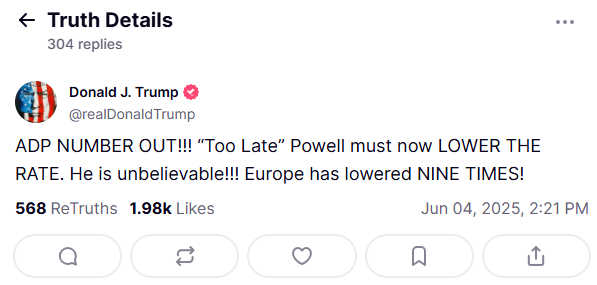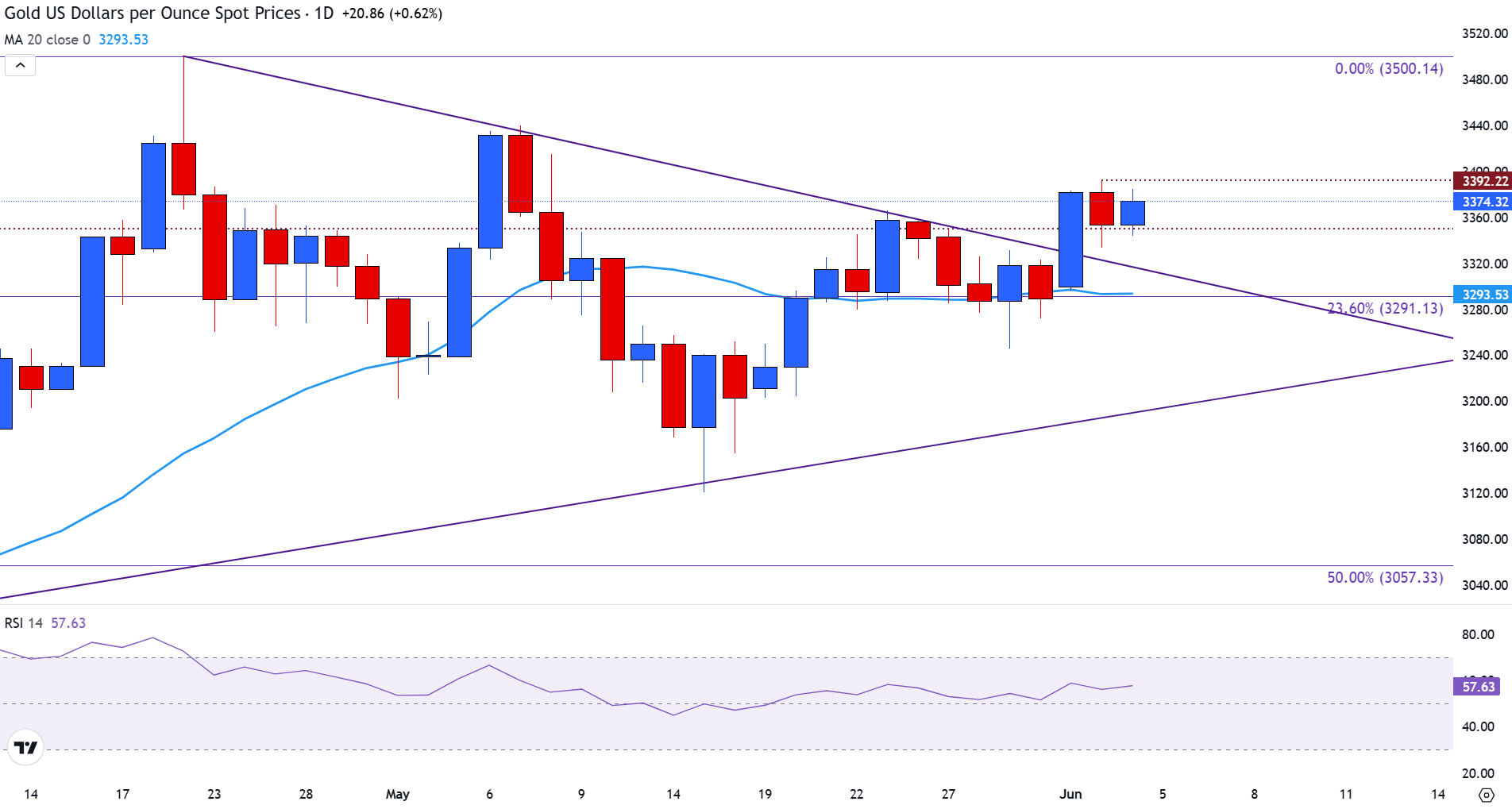Gold prices strengthen following weak US ADP, ISM Services data
- Gold benefits from its safe-haven appeal, with prices firming above $3,350.
- ADP data indicates a softening in the US private sector, bringing Friday’s NFP numbers into focus.
- US President Trump blames Fed Powell for weak data, pressuring the Fed to cut rates.
Gold prices are firming above $3,350 against the US Dollar (USD) on Wednesday after a negative ADP employment release and a poor ISM Services PMI print reduced demand for the Greenback.
At the time of writing, Gold prices are trading near $3,370 with market participants remaining focused on the health of the US labour market and the broader global economic outlook.
US ADP numbers reflect a softening of the labour market, increasing the safe-haven appeal of Gold
With Wednesday’s ADP employment report showing 37,000 jobs being added to the US private sector in May, missing analyst forecasts of an increase of 155,000, the private sector job data provided a limited reaction for Gold prices.
As market participants continue to look ahead to the release of Friday’s Nonfarm (NFP) report, the release of ISM Services data has provided an additional layer of uncertainty surrounding the health of the US economy. Expectations for Friday’s NFP report are for a 177,000 increase in the number of jobs added to the US economy in May, with the unemployment rate expected to remain unchanged at 4.2%.
At 14:00, the Institute of Supply Management released the latest report for May, which reflected a weakening in business conditions in the US service sector. With analysts expecting the ISM Services figures to rise to 52, a reading of 49.9 is reflective of a potential weakening in the perceived business conditions of the service sector, which is the largest contributor of Gross Domestic Product (GDP) in the United States.
In response to the disappointing data, US President Trump posted on Truth Social, pressuring the Federal Reserve (Fed) to cut rates.
With Trump’s remarks stating that the Fed Chair remains “Too Late” to cut rates, markets appear to remain focused on Friday’s Nonfarm Payrolls (NFP) report.
expecting

Source: Truth Social
US 50% tariffs on steel and aluminium are in force
With a 50% tariff rate now in place for aluminum and steel imports into the United States (US), trade relations between the US and its global counterparts remain strained. This provides an additional tailwind for Gold prices and a headwind for major risk assets.
Following positive trade talks between the United States (US) and China in mid-May, which helped ease tensions between the world's two largest economies, the negotiations appear to have stalled.
With both parties accusing each other of violating the agreement reached in Geneva on May 12, uncertainty surrounding trade relations remains a key driver of Gold prices.
However, Gold’s nemesis appears to be the interest-rate trajectory for global central banks, which are preparing to announce the next round of rate decisions this week. Since investors holding Gold bars or coins do not yield any returns from holding these assets, interest rates are seen as a threat, especially when banks offer higher rates.
Gold daily digest: China, tariffs, and employment data drive the US Dollar lower
- Trump said on Wednesday that it was “extremely hard” to make a trade deal with Chinese President Xi Jinping, CNBC reports. The comments arise as Washington has fuelled speculation that a call between the two leaders could happen this week.
- “I like President XI of China, always have, and always will, but he is VERY TOUGH, AND EXTREMELY HARD TO MAKE A DEAL WITH!!!” Trump wrote on Truth Social.
- Chinese Foreign Ministry spokesman, Lin Jian, replied, stating that “China’s principle and position of developing China-US relations is consistent,” Bloomberg reports. The comments suggest that China hasn’t changed its stance since meeting with US representatives last month.
- Prospects of a weak trade deal with China, or even no deal, generally benefit safe-haven assets such as Gold.
- The Geneva deal had established a 90-day pause on escalating tariffs between China and the US, with the US reducing tariffs on Chinese goods from 145% to 30%, and China lowering tariffs from 125% to 10%. The agreement also included provisions for China to lift restrictions on the export of critical minerals essential to US industries.
- With the European Central Bank (ECB) gearing up for Thursday's interest rate decision, the release of the Purchasing Managers' Index (PMI) throughout the morning has provided a mixed picture of the health of the manufacturing and services sectors across the Eurozone. The combination of clear signs of an economic slowdown and slowing inflation is perceived as a warning sign of a potential recession, with spending and demand for goods and services expected to fall.
- For the ECB, inflation data released Tuesday supported market expectations of an additional 25 basis points (bps) rate cut on Thursday.
- As for the Fed, the CME FedWatch Tool continues to show a 55.6% probability of the US central bank announcing a rate cut in September.
Gold technical analysis: Prices find temporary support above $3,350
Gold prices have risen above the $3,350 psychological level, with prices trading in a consolidative phase above a symmetrical triangle on the daily chart, hovering near $3,370 at the time of writing.
For bulls to regain confidence, the next critical level of resistance remains firm at Tuesday’s high of $3,392, a break of which could open the door for the $3,400 psychological level and toward the all-time high of $3,500.
However, risks to the downside remain, with the first significant level of support steadying at $3,350.
Despite a break above the triangle resistance, prices have failed to gain momentum above $3,350, a level that remains critical for Gold’s near-term move.
The 20-day Simple Moving Average (SMA), currently at $3,293, offers additional support.
A break below this level and the triangle base near $3,290 (aligned with the 23.6% Fibonacci retracement of the January-April rally) would expose the $3,057 support zone, marking the midpoint of the aforementioned move.
A deeper decline could extend to $2,804, the 78.6% Fibonacci retracement, if bearish pressure intensifies. The Relative Strength Index (RSI) at 57 supports a mildly bullish bias, but a clear directional move will depend on a breakout from the current range.
Gold daily chart

Gold FAQs
Gold has played a key role in human’s history as it has been widely used as a store of value and medium of exchange. Currently, apart from its shine and usage for jewelry, the precious metal is widely seen as a safe-haven asset, meaning that it is considered a good investment during turbulent times. Gold is also widely seen as a hedge against inflation and against depreciating currencies as it doesn’t rely on any specific issuer or government.
Central banks are the biggest Gold holders. In their aim to support their currencies in turbulent times, central banks tend to diversify their reserves and buy Gold to improve the perceived strength of the economy and the currency. High Gold reserves can be a source of trust for a country’s solvency. Central banks added 1,136 tonnes of Gold worth around $70 billion to their reserves in 2022, according to data from the World Gold Council. This is the highest yearly purchase since records began. Central banks from emerging economies such as China, India and Turkey are quickly increasing their Gold reserves.
Gold has an inverse correlation with the US Dollar and US Treasuries, which are both major reserve and safe-haven assets. When the Dollar depreciates, Gold tends to rise, enabling investors and central banks to diversify their assets in turbulent times. Gold is also inversely correlated with risk assets. A rally in the stock market tends to weaken Gold price, while sell-offs in riskier markets tend to favor the precious metal.
The price can move due to a wide range of factors. Geopolitical instability or fears of a deep recession can quickly make Gold price escalate due to its safe-haven status. As a yield-less asset, Gold tends to rise with lower interest rates, while higher cost of money usually weighs down on the yellow metal. Still, most moves depend on how the US Dollar (USD) behaves as the asset is priced in dollars (XAU/USD). A strong Dollar tends to keep the price of Gold controlled, whereas a weaker Dollar is likely to push Gold prices up.



